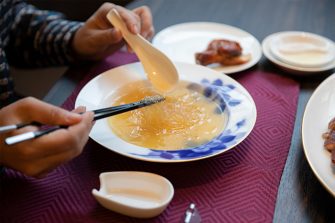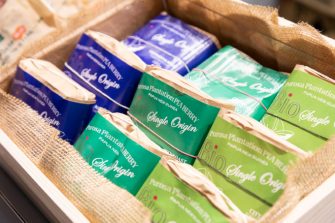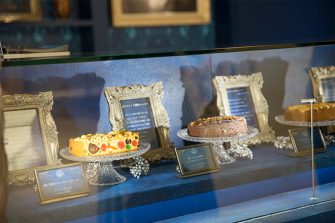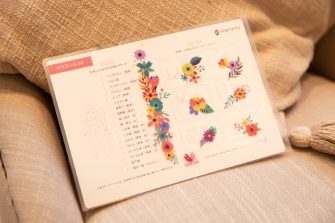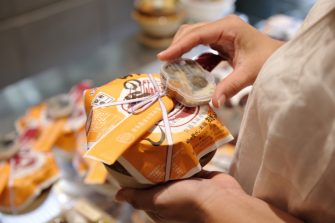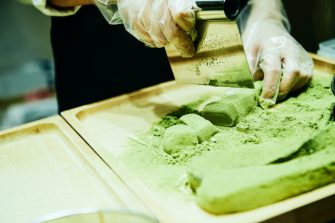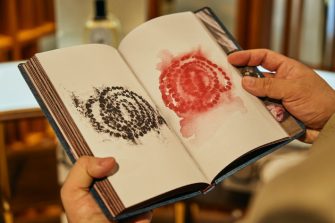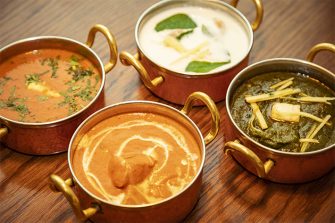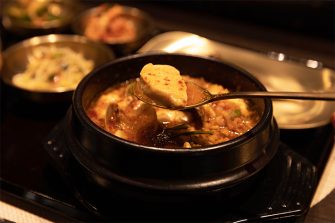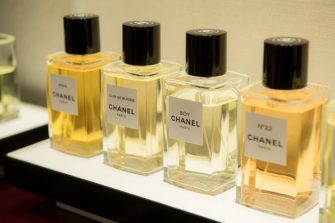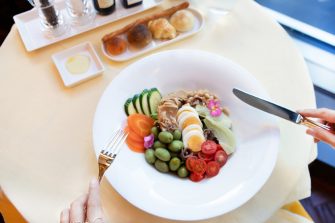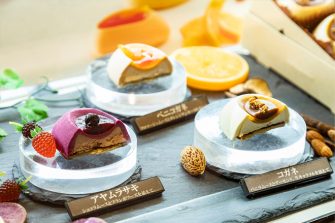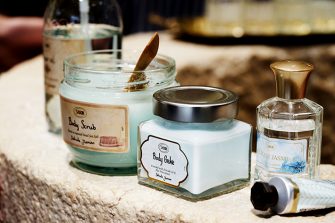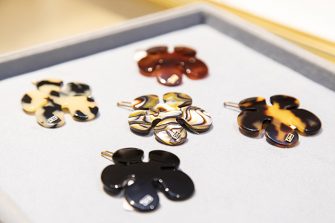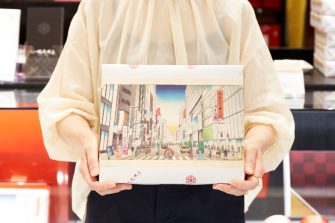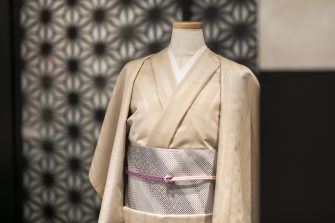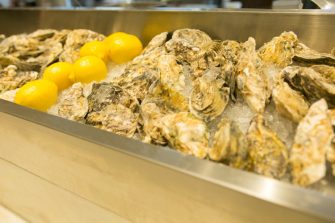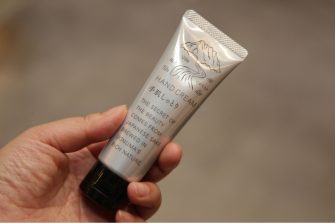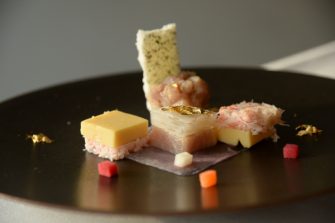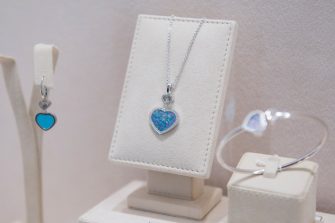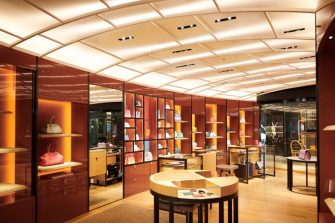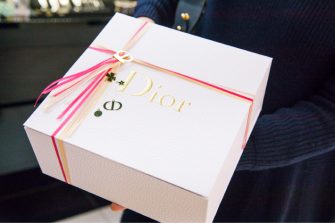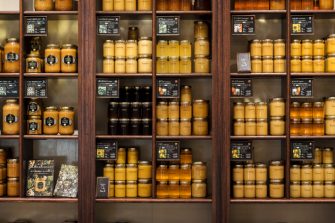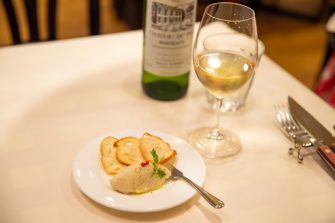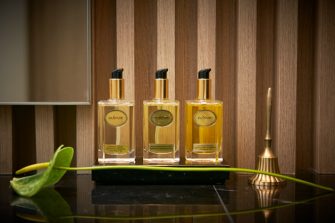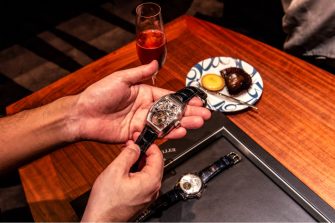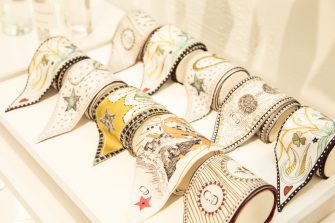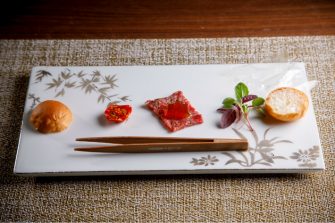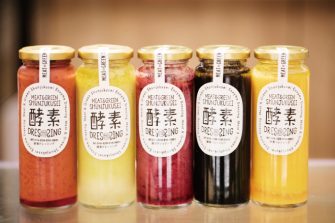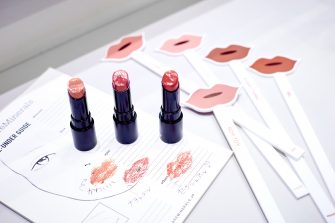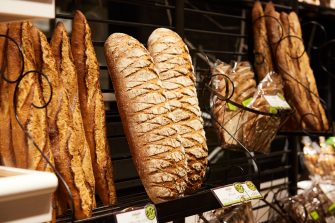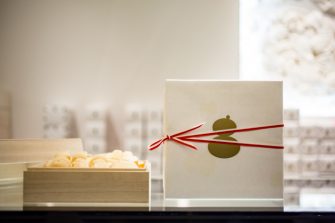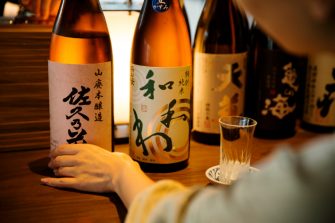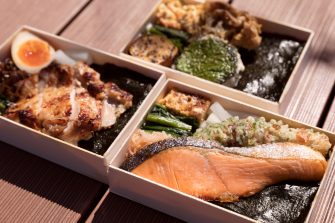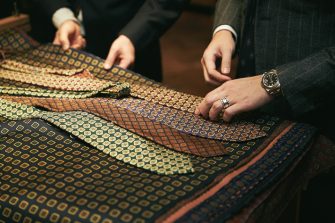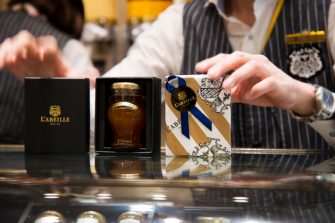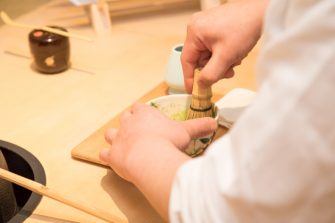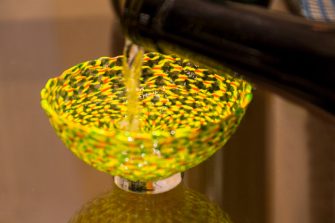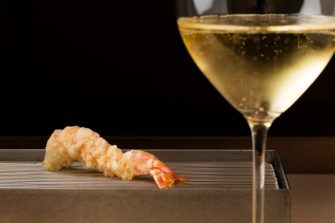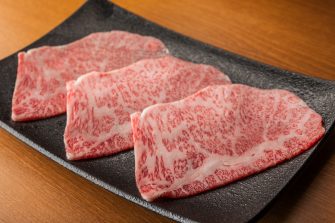

GINZA SIX EDITORS
ファッション、ジュエリー&ウォッチ、ライフスタイル、ビューティ、フード…
各ジャンルに精通する個性豊かなエディターたちが、GINZA SIXをぶらぶらと
歩いて見つけた楽しみ方を綴ります。
食いしん坊の魂百まで? 銀座で旅する食の記憶 A Foodie from Cradle to Grave? Memories of Food in Ginza
山路 美佐 編集者
GINZA SIX EDITORS Vol.116
とにかく小さな頃から食べ物への興味が人一倍強かった。不思議なもので、こうした執着というものは、誰かの影響、ということではなく、生まれた時から自然に個人のDNAに組み込まれているとしか思えない。
例えば、私が人生で初めて文字を読んだのは、1歳10ヶ月のとき。和菓子屋の店先の“すあま”だったと母が教えてくれた。またあるとき、四柱推命で自分の名前を調べてみると、命式に“食神”という星が二つもあった。この星が持つ意味は「快楽」と「食通」だというから、まさに天が“食いしん坊”の人生をくれたのだと自分の飽くなき食への探究心に納得した。
こうして、生まれながらの食べることへの並々ならぬ関心は、そのまま職業になり、国内外を旅をしながら食の現場を取材する編集者となって今に至る。そんな食いしん坊の魂に刻まれた美味なる記憶は、何年経っても色鮮やかに蘇るということを先日訪れたGINZA SIXにて改めて知ったのだった。
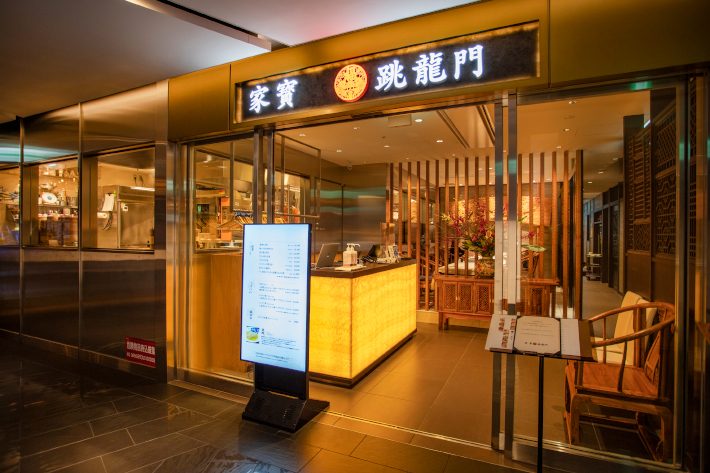
この日、GINZA SIXを訪れたのは、「家寳 跳龍門」(6F)に行くためだった。2021年9月にオープンしたこちらのお店で腕を振るうのは、袁家寳(えんかぽ)氏。16歳で銀座の「福臨門海鮮酒家」の厨房に入り、長年総料理長に。最後は「福臨門海鮮酒家」から屋号が変わった「家全七福」の日本全店の統括シェフを務めていた人物だ。
「福臨門海鮮酒家」といえば、誰もが知る広東料理の超高級店。2度目に香港を訪れた1995年、思い切り背伸びをして初めて訪れた。そのときに食べたフカヒレが、今までの自分が体験したことのない味だったことを覚えている。銀座の「福臨門海鮮酒家」もまた、銀座の高級広東料理の代名詞、訪れるには敷居が高い憧れの店だった。
そんな店の味を支えていたシェフが新たに店をオープンしたと聞いて、早速予約をしたのだ。
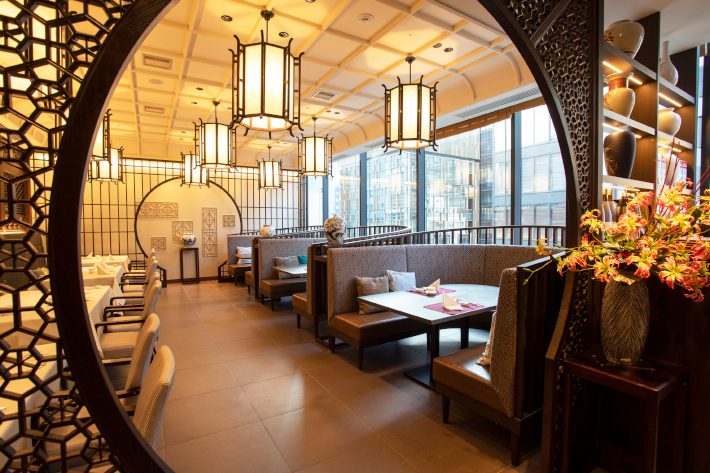
エレベーターで6Fまであがり、一番奥に向かうとエントランスが見えてきた。予約を告げて中に入る。中国格子に仕切られた先に広がるシックな店内にはゆったりとしたソファ席とテーブル席が並んでいる。おすすめはソファ席。他のテーブルのゲストの視線を気にせずに、ゆっくりと食べることができる。窓から銀座の街並みが見えるのもいい。
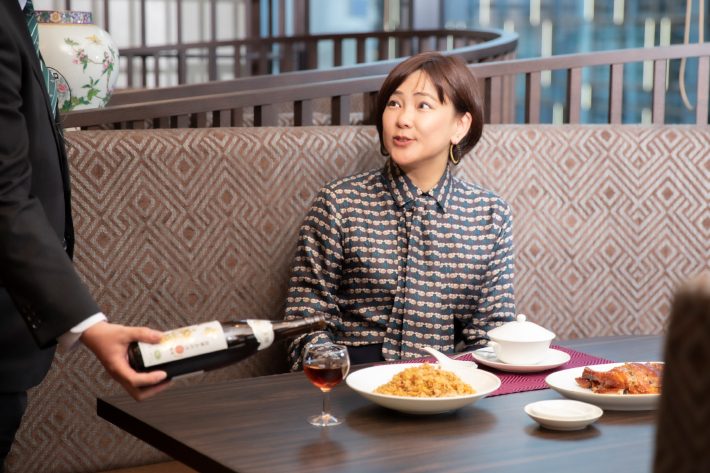
さて、メニューを開いて、何を食べるかサービスの方と作戦を練る。最初のオーダーが肝心だ。まず目に入ってきたのは、袁家寳シェフの名前がついた「KAPPO脆皮鶏(鶏クリスピーの姿揚げ)」(半羽4,950円・一羽9,900円 ※以下全て税込価格)。思い起こせば香港で感動した料理の一つに鶏肉の丸揚げがあった。皮が薄くてパリッとしているのに、身はしっとりしていて、肉と脂の旨みが濃い。瞼を閉じれば、あのころの香港の喧騒が……。そんなことを思い出しながら、半身を注文。

ほどなくして、テーブルにやってきたつややかな「脆皮鶏」。これこれ!と思いながらひと口パクリ。まさに文字通り、歯に当たるとパリッとハラっと崩れる皮の食感、そして続いてしっとりと吸い付くような肉を噛み締める。脂の旨味がじんわり広がって……。ちなみに、鶏肉は茨城県の香りがあって皮が薄く、脂がのっている品種を選んでいるそう。うーん!これぞ、まさに香港の味だ。
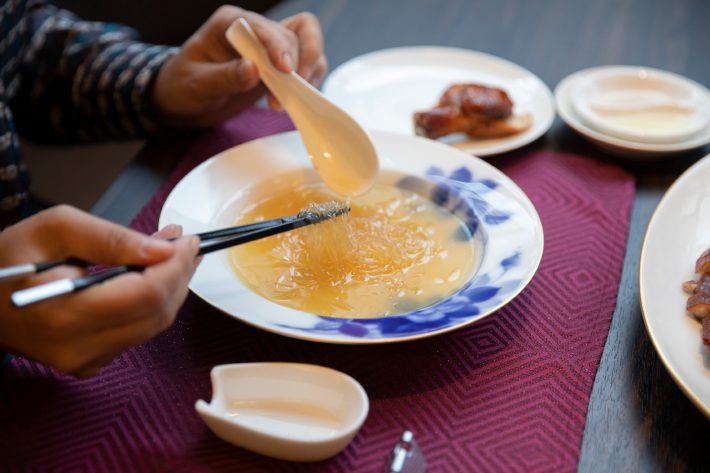
さて、次は何を頼もう。やはりここは、私が30年近く前、当時清水の舞台から飛び降りる気持ちで初めて注文し、衝撃を受けたフカヒレにするしかない。
当時、ひよっこの私は、日本ではフカヒレといえばソバの上にのっている、10cmくらいの小さなフカヒレしか食べたことがなかった。それがだ。香港で出会ったそれは、姿煮ではなく、ソバ状のきらきらとした透明の太い繊維状のものが黄金のスープのなかで輝いていた。これが、フカヒレ!?
そう驚いたことを覚えている。そして、たっぷりの上湯とともに食べて、スープの味を楽しむのが、本来のフカヒレなのだと知ったのだった。
目の前に出された、「至高フカヒレ上湯煮込み」(17,600円)は、当時の記憶と同じ黄金色のオーラを放っていた。黄金のスープを一口飲めば、すっきりとした中に複雑な旨味が幾重にも広がる。
ああ、このスープ。フカヒレに染み渡るスープは、驚くほど透明感があり、かつ風味が際立ち、品が良い。使っている材料は、鶏肉、豚肉、金華ハムといたって普通。それなのに、このクリアで旨味があるのに澄んだスープは全然他と違う! おいしさの秘密を聞くと、「大切なのは素材を見極める目にあり」と家寳シェフ。それはスープに限らずすべての料理において大切なことだそう。
高貴なスープをまとったフカヒレの食感を噛みしめる幸せよ。フカヒレをソバのようにたっぷり食べる贅沢に、しばし恍惚となる。
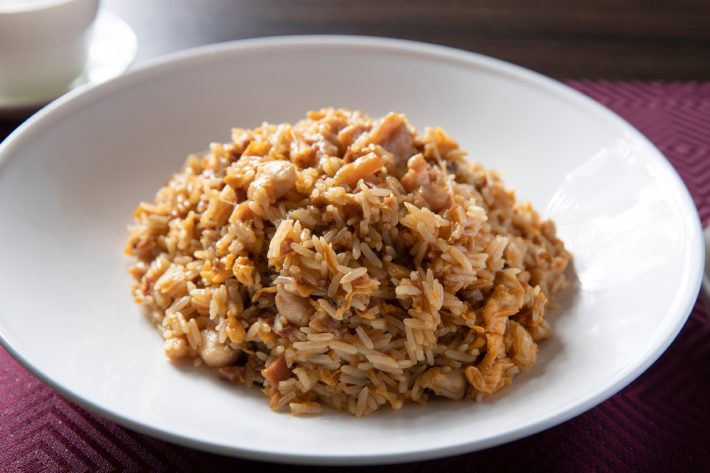
そして、最後の締めは、もちろん「福臨門海鮮酒家」を彷彿とさせる、「干し鮑汁を入れた干しイカと鶏肉の炒飯」(2,600円)。鶏肉や釜焼チャーシュー、戻したスルメイカで炒飯をつくり、最後に鮑の戻し汁を加えて仕上げたものだ。パラッとした米粒の食感は残しながらも、旨味たっぷりの水分をまとってしっとりした独特の食感は、満腹でもスルスルと胃の中に収まっていく。ちなみに「福臨門海鮮酒家」では干しタコを使うが、それを干しスルメでつくるのが家寶流だ。
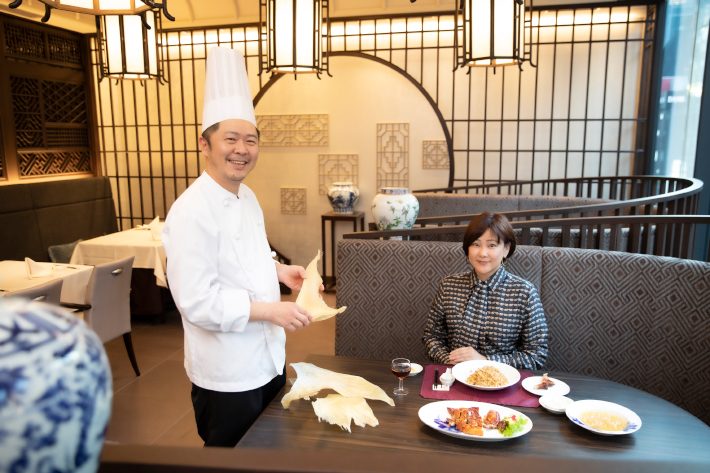
「干しスルメイカの出汁がよく出て、炒飯に合うと思ったんですよね。スープや、乾物の戻し方や、素材の選び方などの基本は『福臨門海鮮酒家』時代で学んだことを踏襲しながら、自分がやりたかったことや、面白いと思うこともチャレンジしたいですね」と笑顔で話す家寳シェフ。
少しお話をさせていただいて、すっかりそのチャーミングな人柄に惚れてしまった私。とにかく、おいしいものを作りたい!おしいもの食べてほしい!という気持ちがオーラになって溢れている。シェフ、ランチの焼味(シュウメイ)がご飯にのったセットも気になるから、近いうちにまた行きます!
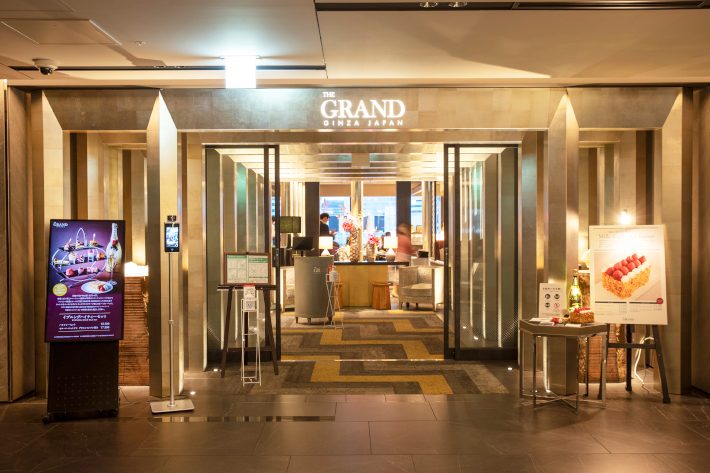
さて、30年前の香港旅行の記憶を辿る食事をしたら、もっと前に遡る食の記憶がGINZA SIXにあることを思い出した。その思い出をデザートにしようと向かったのは、「THE GRAND GINZA(ザ・グラン銀座)」(13F)。お目当ては、ここで食べられる銀座マキシム・ド・パリの味を受け継ぐ「苺のミルフィーユ」だ。

実は私、学生時代に渋谷東急本店地下にあった、銀座マキシム・ド・パリのケーキショップでアルバイトをしていた。銀座マキシム・ド・パリが、1966年に誕生して以来、本場フランスの味を楽しむ大人の社交場だった伝説のレストランだとは知らずに働いていたと思う。

当時のバイト先には、手土産にするのだろう、企業の秘書風の人や、サラリーマンが良く買いに来た。このミルフィーユのリッチな美味しさは、店の偉大さを知らないバイトの私でも夢中になった。
学生が買うにはそれなりに高額だった記憶があるが、それでもたまに、奮発して家に買って帰り、家族と食べるのを楽しみにしていた思い出のケーキなのだ。
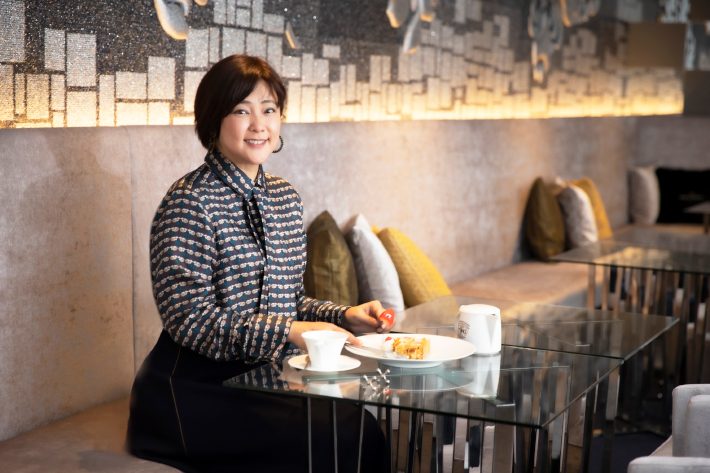
「THE GRAND GINZA」でも数量限定で販売中の「苺のミルフィーユ」(ハーフサイズ 3,240円・フルサイズ6,480円・ワンカット 1,460円)は、そんな思い出深い当時のマキシムのレシピがベース。カスタードとパイを重ねて、端正な長方形に整えた後、アーモンドで周りを飾って、苺を並べて、生クリームをひと絞り。あの懐かしい憧れのケーキと、ここで再会したことに思わず感涙……しそうに。
銀座のマキシムも、渋谷のケーキショップもなくなってしまったけれど、ここであの味を楽しめる日がくるなんて! 感慨深く一口食べると、記憶の味よりちょっと大人の味になっているような……。
聞けば、こちらのレシピを監修しているのは「銀座マキシム・ド・パリ」初代パティシエ。店のゲストのイメージに合わせて、従来のレシピのカスタードクリームにコアントローを多めに効かせているのだそう。大人になった今、むしろこの味も好みかもしれない。
注文が入ってからパイとクリームを組み立て作るので、気持ちいいくらいのサクサク感がいい。見た目はかなりボリュームがあるけれど、クリームもパイも軽やかなのでペロリと平らげてしまう。合わせるのは苺のフレーバーがする、TWGの「1837ブラックティー」がおすすめ。華やかな香りがミルフィーユともよく合うんだな、これが。
このミルフィーユ、大人気で売り切れることも多いそう。お店に向かう前に電話をして予約をすることを忘れずに。
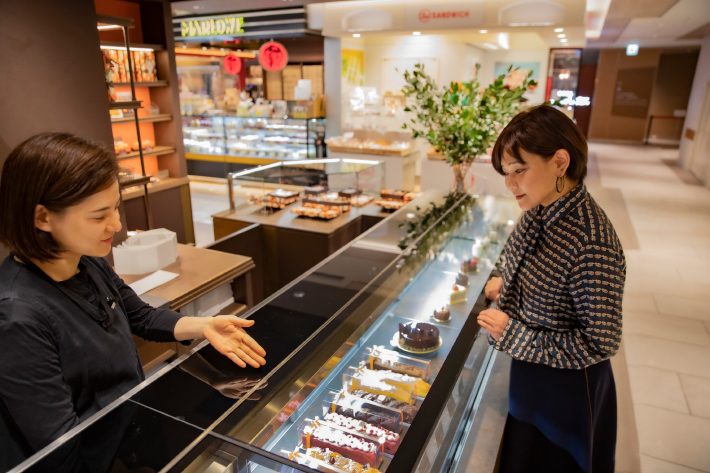
なんだか食の記憶を辿っていたら、おいしいものを買って実家に帰りたくなった。どうせなら、お土産も私にとって素敵な思い出があるお店で調達しよう。
そう向かったのは、2021年5月に登場した「アルノー・ラエール パリ」(B2F)だ。
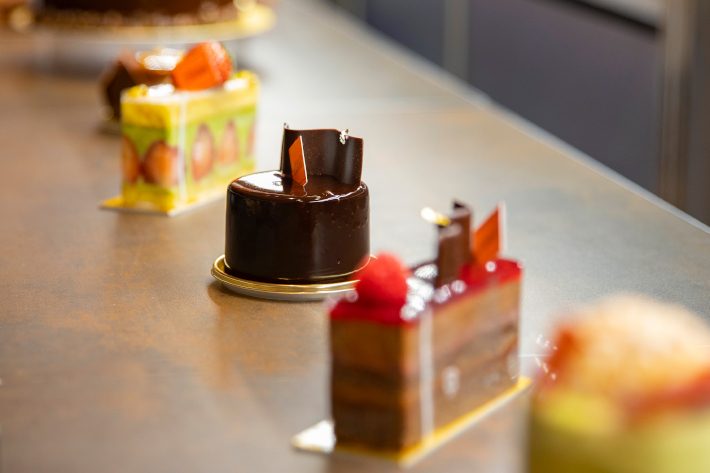
こちらのお店との出会いは、2007年、当時担当していた雑誌の取材でパリに行ったときのこと。M.O.F.(フランス国家最優秀職人章)受章パティシエ、アルノー・ラエールさんの店と聞いて、どんな荘厳なお店なのかと想像をふくらませていた。ところが、モンマルトルにあるショップは、住宅街にある普通のお菓子屋さんといったさりげない佇まいでちょっと拍子抜けしたことを覚えている。
けれど、中に入ってショーケースをみたときに驚いた。細部まで美しく作られたお菓子が放つオーラに圧倒された。特に、お店のスペシャリテでもあるチョコレートケーキ「トゥールーズ=ロートレック」(小1個 760円・ホール 4,560円)に釘付けになった。もちろんGINZA SIXのお店のショーケースでも売られている。ツヤツヤと光る美しいケーキは、食べたら中のチョコレートムースの香りがすばらしく、はっとするほど洗練された味わい。その同じ味が日本でも買えるなんて!
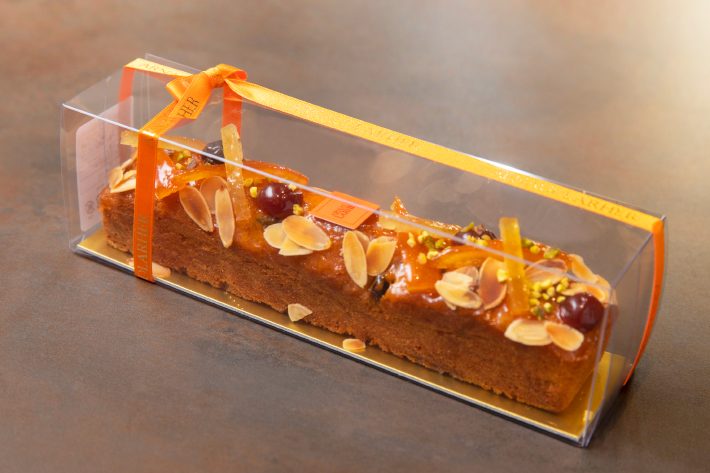
この日は、「トゥールーズ=ロートレック」のほかに、見た目もかわいい「ケークフリュイ」(2,100円)を購入。みっしりとドライフルーツとナッツがデコレーションされているケークは、小さくスライスしても食べごたえ十分。日持ちもするし、クリアケースのパッケージが可愛くって手土産にはぴったりだ。
ちなみに、こちらのお店、フランスから空輸されるショコラもおすすめ。特にお気に入りは「コフレフュメ」。燻製したカカオのガナッシュでつくるショコラは、そのままでもいいけれど、ふわりと漂う薫香がウイスキーなどのお酒に合うので男性に差し上げるのにも重宝している。ちなみに、たまに自分用にも買うのだけれど、一粒食べるとクセになってしまうので、食べ過ぎに注意。

お腹もいっぱいになって、家族に渡すおみやげも買って、なんだか幸せな気分でGINZA SIXを出た。
GINZA SIXには新しい刺激もあるし、受け継がれていく美味にも出会える懐が深い場所。香港、パリ、東京、そして学生時代から今現在まで、銀座にいながらにして、時空も距離も飛び越えて旅をした。そんな時間を過ごすなかで、自分のなかに生き続けるキラキラとした食べ物の記憶のカケラと久しぶりに出逢えたのも愛おしかった。
そして、GINZA SIXで思いがけず記憶の旅をたどって改めてわかったことは、1歳の“すあま”を読んだときから歳を重ねた今まで、食に対する貪欲な好奇心はまったく変わっていないということ。
食いしん坊の魂百まで、ということなんだろう。
Text: Misa Yamaji Photos: Michika Mochizuki Edit: Yuka Okada(81)
I’ve been far more interested in food than most people ever since I was child. However, my attachment with it can’t be traced to any one individual, and simply seems to have been a part of my DNA from the time of my birth.
The very first word I was able to read was “suama,” a Japanese sweet, at age one year and ten months, in front of a Japanese confectionary, according to my mother who told me later. One time, I looked up my name according to The Four Pillars of Destiny astrology, which revealed my fate was linked with two Cookery God stars. Since the meaning of this star is ‘pleasure’ and ‘gourmet,’ I realized my inexhaustible passion for food makes perfect sense—it was written in the stars.
Born with an innate interest in food, I’ve made food my career. I have travelled both within Japan and abroad as an editor covering the food scene. At GINZA SIX the other day, I learned once again that the delicious memories etched into the soul of a foodie can be vividly revived even after many years have passed.

On this particular day, I went to GINZA SIX specifically to visit KAPO CHOURYUMON (6th floor), a restaurant, headed by Kapo En, that opened in September 2021. Having joined the kitchen at Fook Lam Moon in Ginza when he was 16, En served for many years as head chef. More recently, after Fook Lam Moon changed its name to Seventh Son Restaurant, he served as executive chef for the entire chain in Japan.
Fook Lam Moon is a highly acclaimed restaurant renowned for Cantonese cuisine, and it was on my second visit to Hong Kong, in 1995, that I took the plunge and resolved to visit this establishment. The shark fin I tasted that day was unlike anything I’d ever tasted before, I remember feeling. The Fook Lam Moon in Ginza, too, was synonymous with high-end Cantonese cuisine. I often longed to eat there but felt self-conscious about actually stepping in.
However, when I heard the chef responsible for those flavors was opening a new restaurant, I immediately made a reservation.

On my visit there, I took the elevator up to the sixth floor and proceeded toward the very back, where I found the entrance. I mentioned my reservation and walked in. The chic, spacious interior, partitioned by a Chinese lattice, featured comfortable sofas and tables. I recommend the sofas, since if seated on one you don’t have to worry about the gaze of customers at other tables and can enjoy your meal in peaceful isolation. You can also enjoy a view of Ginza’s streetscape from the window.

I opened the menu and talked tactics with my server; your first order is crucial. What first caught my eye is KAPPO Crispy Chicken (crispy deep-fried chicken) (half chicken 4,950 yen, whole chicken 9,900 yen; all prices listed include tax). In Hong Kong, the deep-fried whole chicken had been one of the most impressive dishes. The skin is thin and crispy, but the interior is juicy; both the fat and meat are flavorful. Closing my eyes, I could see the hustle and bustle of Hong Kong in those days. With this in mind, I ordered a half chicken.

After a short time, the shiny Crispy Chicken arrived at my table. This is the one! I thought, as I took a bite. The texture was just as described. I crunched down on the crispy skin, which broke apart, followed by succulent strands of meat joined to the panes of skin, with the fatty flavors gradually unfolding. Incidentally, the chicken itself was an aromatic breed from Ibaraki Prefecture with thin skin and fatty meat. Yes, this was what I’d hoped for . . . the authentic Hong Kong flavor!

So, what to order next? I knew I had to go for the shark fin, the same dish that had made such an impression on me some 30 years ago when taking the plunge for the first time.
A mere naïf at the time, I had only ever eaten a small piece of shark’s fin around 10 cm long served on top of noodles. But here it is. The shark fin I had in Hong Kong wasn’t braised. It was thick and fibrous like soba noodles, transparent and glittering in a golden soup. This is shark’s fin?!
I remember my surprise. Traditionally, I learned at that time, shark’s fin is eaten with plenty of shantan broth, to enjoy the flavors of the soup.
The Supreme Boiled Shark Fin in Shantan Broth (17,600 yen) presented gave off that same golden aura. A sip of this golden soup reveals layers of refreshing but complex umami flavors.
This soup! Diffused into the shark’s fin, it proved surprisingly transparent, with a characteristic and highly refined flavor. The ingredients were the usual—chicken, pork, and Jinhua ham. But the clear flavorful soup was like none other. I asked Chef Kapo to divulge the secret. “What matters is an eye for the ingredients,” he explained. “This is important not just for soup, but for all dishes.”
Chewing shark’s fin in an exquisite soup was an experience of bliss. The luxury of eating shark’s fin in volumes, as if it were noodles, was nothing short of rapturous.

And after that, to close, I went with the Dried Squid and Chicken Fried Rice with Dried Abalone Broth (2,600 yen), which conjured vivid memories of Fook Lam Moon. The fried rice is made with chicken, kettle-roasted pork, and rehydrated dried squid and finished with the addition of reconstituted abalone broth, which retains the texture of the non-sticky rice grains while the unique juicy texture resulting from the flavorful broth slides nicely into your stomach, even if you’re almost full. Incidentally, Fook Lam Moon uses dried octopus, but Kapo chose to make his fried rice with dried squid.

“I thought dried squid would make really good broth that would go well with fried rice,” he said with a cheerful gleam in his eye. “I learned the basics of soup, how to rehydrate dried foods and select ingredients during my time at Fook Lam Moon. Drawing on this knowledge, I want to try something interesting, something I wanted to do. I want a challenge.”
My conversation with Chef Kapo left me thoroughly charmed. If his aura spoke, it would say: “I want to make wonderful food! I want you to eat wonderful food!” My fascination with this chef and a lunch set with siu mei (roasted meat) on rice had me laying plans to come back.

This meal, which brought back memories of a trip to Hong Kong 30 years ago, jogged the memory of a dessert I recall from even further back. Realizing I could have it right here at GINZA SIX, I went to THE GRAND GINZA (13F). The delicacy I found myself directed to was strawberry mille-feuille, which carries on the traditional flavors of Maxim’s de Paris.

I may have failed to mention that I worked part-time when I was a student at the cake shop of Maxim’s de Paris. This was located on a basement floor of the Tokyu Department Store in Shibuya. At the time I worked there, I had no idea of Maxim’s de Paris standing as a legendary restaurant, a gathering place for those who loved authentic French food since its establishment in Ginza in 1966.

During my time there, many businessmen and people I assumed were secretaries would come to buy small gifts and souvenirs. I didn’t know the shop I was working at had such a reputation, but I did know I was absolutely crazy for the rich and delicious mille-feuille.
It was an expensive dessert for a student. Even so, I would be inspired from time to time to buy one for my family and bring it home. I remember looking forward to partaking in it with everyone.

The strawberry mille-feuille sold in limited quantities at THE GRAND GINZA (half size 3,240 yen, full size 6,480 yen, one piece 1,460 yen) is based on the recipe at Maxim’s from the times I remember so well. Layers of custard and pie are formed into a clean-cut rectangle decorated with almonds on the sides and topped with strawberries and whipped cream. Unexpectedly, as I sat at the table enjoying a cake that brings back so many affectionate memories, I found myself moved close to tears.
The Maxim’s in Ginza and its cake shop in Shibuya are both gone now. Who knew the day would come when I could enjoy those same great flavors here! I took a bite in which flavors mingled with memories. And it actually had a more ‘grown-up’ flavor, less of a merely childish delight, than I remember.
When I inquired, I learned that the recipe was supervised by Maxim’s de Paris’ first-generation pâtissier. Matched to the profile of the restaurant’s patrons, Cointreau is used more liberally in the custard cream than in the original recipe. Now, as an adult, I find myself more partial to this version.
The pie and cream are assembled to make the cake when an order comes in. This timing results in a very pleasurable crunchiness. The cake is a fairly voluminous confection, but the cream and pie are light. You’ll clear your plate faster than you might expect. The recommendation is to have it with TWG’s strawberry-flavored 1837 Black Tea. The brilliant aroma of this tea is a perfect match for mille-feuille.
This mille-feuille often sells out—it’s very popular. Don’t forget to call and reserve yours before you go.

Having relived this delicious memory, I found myself wanting to buy something delectable to take to my parent’s house. I decided to buy a gift at another shop I have fond memories of, which is why I ended up at Arnaud Larher Paris (B2F), which opened in May 2021.

I first encountered this pastry shop in Paris to cover a story for the magazine I wrote for at the time. I’d heard of a shop associated with Arnaud Larher, recipient of a Meilleur Ouvrier de France (MOF) award as one of the country’s finest craftpeople. Based on that, I had imagined some majestic establishment. In fact, a little to my disappointment, his shop in Montmartre looked like any other residential pastry shop.
But, peering into the showcase, I was astonished at the intricate, beautiful pastries on display. My eyes remained fixed on the Toulouse Lautrec, a chocolate cake and one of the shop’s specialties. When you bite into this lovely gleaming cake, you encounter chocolate mousse and wonderful aromas. The taste is breathtakingly refined. And a version of this is also present in the showcase at the GINZA SIX shop (small 760 yen, whole 4,560 yen). I couldn’t believe I could purchase the same cake in Japan!

On this day, along with the Toulouse Lautrec, I bought a charming Cake aux Fruits (2,100 yen). Liberally dotted with dried fruits and nuts, this cake, even a small slice, is more than satisfying. This long-lasting cake also makes the perfect gift, wrapped in an adorable clear package.
The shop’s chocolates, shipped in directly from France by air, also come highly recommended. I’m especially fond of the Coffret Fumé. The chocolate, made with smoked cocoa ganache, is great on its own, but a waft of its aroma goes very well with liquors, like whisky. It’d work well as a gift for a man, too. I do buy them for myself sometimes—but if I eat just one, I know I’ll want one more, and then another, which makes me cautious!

I left GINZA SIX with a satiated palate, souvenirs for my family in hand, and in a wonderful mood.
GINZA SIX provides new stimulation and nostalgic encounters with traditional tastes that have been inherited for many years. Hong Kong, Paris, Tokyo, from my student years to the present, I’ve traveled great distances beyond space-time without ever leaving Ginza. And alongside the path of sweet flavors, I rekindled sweet memories of food long dormant within.
Something else my trip down memory lane at GINZA SIX reminded me of is that my insatiable curiosity for food has not changed since the time I read my first word at the age of one. From cradle to grave I expect to be a foodie.
Text: Misa Yamaji Photos: Michika Mochizuki Edit: Yuka Okada(81)
山路 美佐
株式会社B.EAT代表 雑誌「家庭画報」編集部に勤務したのち、web系グルメマガジン「ヒトサラ」副編集長を経てフリーランスに。現在女性誌などでの執筆、医師のためのポータルサイト・M3内WEBマガジン「Doctor’s Lifestyle」の編集、企業向けのコンテンツ制作、企画、商品開発などを行う。Instagram : @misamisa_0213


